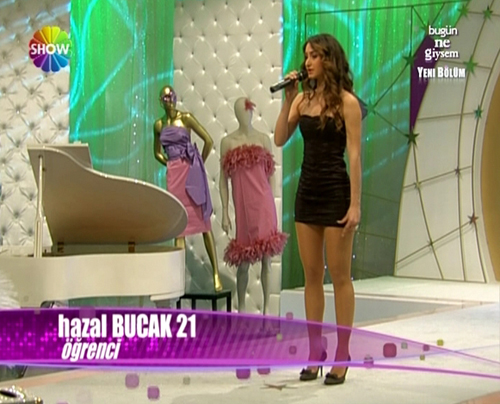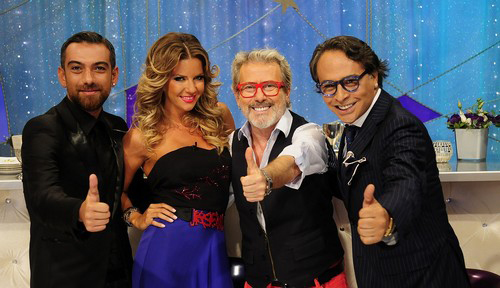“Bugün Ne Giysem?” and Design Education
“Bugün Ne Giysem?” (“What Shall I Wear Today?”) is a TV show in Turkey where female contestants come up with a clothing/style for each episode and get critique from judges (fashion icons/designers) who decide whether they go through to the next round or not. The show claims to be in search of “the most stylish woman in Turkey”. The judges also claim that they are educating the viewers while giving critique to the contestants and thus leading women in Turkey towards a better-looking future. As an avid fan of the show, however, I observe that their method is flawed. I propose that they may do better in their idealistic task if they take one step further in their educating. Now I don’t know a thing about fashion or clothing, but I’ll make my case as a (visual communication) design professional and you’ll see how it relates.

A typical conversation between the judges and a contestant is like this:
— The color of your shoes is very wrong. Why did you choose that color?
— Because I like that color…
— You could’ve picked a bright green instead.
or
— That dress is a very wrong choice considering your body type. Why did you buy it?
— I don’t know… Because I liked it…
— That’s not a good choice.
So what’s the problem here? I see two. The first problem is with the contestant’s almost tautological answer, but it’s natural, given that these are people with no fashion/design education. The second, and the bigger problem, is with the way judges respond to that. They tend to offer specific and temporary fixes, and ignore the main issue; if only somebody told these women that style (or indeed design) decisions are not just about what you personally like!
As far as I understand from the show, personal styling is very much like design in general: you start with a project/problem/brief, and look for solutions. What problem? What is the design brief, indicating the questions to be answered, giving the context against which the solutions are judged, in the case of this show? What is the content at hand? Well, as the judges frequently hint, the “given” content and problems include your height, your weight, your body type, your skin tone, the beauty level of certain parts of your body (face, shoulders, knees, etc.), and where you plan to go in that dress/make-up. Once you have these constraints, the rest is some kind of optimization – with multiple solutions, of course. For instance, if you are short (and if you’re not entirely happy with that), you should avoid flat shoes. If you have a beautiful face, you should make it visible by tying your hair up. Simple as that. Just keep track of the “if”s. [The “if”s multiply in number as soon as you start to make decisions: if you have nice toes, you may pick open-tip shoes. Then this becomes a new “if” in your system: if you wear open-tip shoes, don’t ever wear pantyhose. So now you don’t have the right to say “I wore pantyhose because I like it.“]
It appears that the parallels between styling and other design disciplines go further than this. Consider this dialogue from the show:
— Why did you choose that color for your purse?
— I wanted it to match the color of my shoes.
— But they don’t exactly match.
— They’re close…
— Close isn’t good enough.
This is the famous ambiguity problem in design. Things (colors, distances, typefaces, etc.) should be either exactly the same or distinguishably different from each other; in-between isn’t good since it puts a cognitive load on the viewer – an unconscious monologue like “Are these the same? No, they’re different… Or are they?” Another example:
— You have a huge gold bracelet on your arm, and then you have the huge gold necklace on your neck… One huge gold thing should be enough.
This is the hierarchy problem. “There should be only one boss”, or “Elements shouldn’t be competing”, as we say in editorial/layout design. So not only styling resembles design in its overall nature, it also shares the basic principles common to other design fields.
As in every design discipline, clothing design (and styling in general) has its long-tried and well-known solutions to common types of problems, though you can always go creative and invent your own solutions. The judges in “Bugün Ne Giysem?” applaud those rare creative contestants, and spell out those well-known solutions for the unsuccessful ones, but they never reveal the true nature of the process: they never explicitly tell that this is best learned as a problem-solving process which has very little to do with what you “like”. This may seem like a theoretical issue, but it makes a huge difference in the intended “style education of women in Turkey”. Avoiding it strengthens the belief that picking the right clothes, looking good, being stylish (and getting good critique) all have to do with this thing called “taste”. And this rather mysterious, supernatural “taste” thing, you either got it or not. But tastes may also differ. (Yes, it’s not a coherent belief system.) If your look is ugly to me, then you obviously have no taste. If you don’t like my look, then your taste is different from mine. If the judges don’t approve my look, they sure have different tastes, and there’s nothing objectively wrong about my look – now you see how that “theoretical” issue in styling (or design) education ruins everything that the educator tries to accomplish.
[The taste issue is just as problematic in visual communication design: the taste of the CEO of the company – ideally – should have nothing to do with the corporate identity design of that company. She may hate the color blue, but blue may be the objectively right choice given the design brief at hand.]

On “Bugün Ne Giysem?” we too often see this taste defense on the part of the contestants, to which the judges apologetically reply by babbling something like “Well, we’re judges in this show, we’re supposed to give you critique…” Instead, they should be asserting “Forget about your taste, think of problem-solving!” They should, just as design educators do, make it perfectly clear that they won’t take “Because I like it” for an answer.
I am not claiming that taste, or talent, has absolutely no role in styling/design, but rather an immensely overrated one. My point is that making good styling/design is an ability that can be learned within a rational discourse, in a way that the taste metaphysics discourages us from. The late American social scientist Donald Campbell makes the same point:
[W]hen publicized as a part of an ideology of creativity, it [the concept of “insight”] can reduce creativity through giving students a feeling that they lack an important gift possessed by some others, a feeling which inhibits creative effort and increases dependence upon authority. (1960, Blind variation and selective retention in creative thought as in other knowledge processes, Psychological Review, 67, 380−400.)
I propose that the judges in “Bugün Ne Giysem?” should stress in every opportunity that personal taste or “liking” has little to do with the success of styling, that styling can be approached as a problem-solving and system-constructing process with predetermined constraints and objective reasons for action, and that one can have rational discussions about those reasons and their results beyond “This is what I like and fuck you if you don’t”. They should do this in order to make a permanent impact on their target group, providing them with the paradigm shift that will illuminate all of their styling decisions in the future. In short, they need to teach design-thinking instead of just giving tips.
Or maybe they need not. This is just a stupid TV show in the end.


Just shared this with the VA301 class, great read.
Reminds me of TV cooking shows where the cook – as an industry professional – actually (often) talks about the problem that occurs when certain ingredients come together and offer solutions as well as defining the problem(s).
Thanks Deniz.
Thank you Servet. Yes, you’re right, and I notice that the design principles like hierarchy or contrast are also in play in those cooking shows. Nevertheless, the taste explanation/defense that I’m complaining about is much more common in fashion/styling shows.
Brilliant! Totally!
But I also kept looking at the screenshot of the set and the photo of the judges themselves I’m afraid. A case of the blind leading the blind? It is like that famous show on BBC with these women called Trinny and Susannah who used to take women clothes shopping. And the poor things usually ended up looking considerably worse than they did to begin with.
Clothing is about identity more than anything else. Everything we put on ourselves is a signifier which gives out highly personal information about us. (And even no-info – like generic clothing for example – becomes its own kind of info btw, so you really cannot get away from it). Which is why it becomes a highly complex “problem” since you cannot really solve it by applying the usual design solutions, such as ambiguity for example. Or why it doesn’t work when someone else takes you shopping like in the BBC program…
Sorry, pressed the button too soon!
When I look at the girl in the screenshot I feel that the biggest problem there is in fact a mis-match of who she is and what she is wearing. The effect is supposed to be “sexy”, but her body language makes it end up being “pathetic”. Like as if she somehow forced herself to get into this “little black dress” look specifically for the show and somewhere along the line it all went wrong. The outfit simply isn’t “her”. The posture is the give-away, the way the feet are, the hand, the fingers…
So, in this sense I would say that getting dressed is a big design problem which primarily involves “content”. Visually you could have perfect contrasts, perfect hierarchies, perfect color and shape combinations, etc etc etc – and still end up looking like a clown, if what you put together wasn’t “you”.
Thank you!
Of course you’re right about the set and some of the judges (Nur Yerlitaş was one of them in the previous season!), though I have confidence in Hakan Akkaya (on the left) – he seems like a person who would get my point.
Your take on the screenshot I put is also a great addition to this post, and I’m glad that you agree with me on the use of the term “content” in styling. Yes, the judges also talk a lot about posture and body language in the show; I would say that they are not strictly “given” but among the things that can be changed with some effort, in some cases.
Really exciting to read. I may have missed it but did you write anything concerning Esra Erol’s TV show which I know you’re familiar with?
I’m sure it would also be very interesting to read.
Thank you Neslihan! Yes, I’m also a big fan of the matchmaking shows in general (not only Esra Erol; I watched Zuhal Topal, Hande Ataizi, Seren Serengil, Sinem Yıldız, Patti Stanger, etc.) but I guess I haven’t written something like this for them. But I did keep this archive for some time, if you’re interested: http://seyrediyorum.wordpress.com/